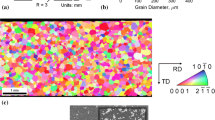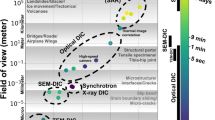Abstract
A series of baseline displacement measurements have been obtained using 2D Digital Image Correlation (2D-DIC) and images from Scanning Electron Microscopes (SEM). Direct correlation of subsets from a reference image to subsets in a series of uncorrected images is used to identify the presence of non-stationary step-changes in the measured displacements. Using image time integration and recently developed approaches to correct residual drift and spatial distortions in recorded images, results clearly indicate that the corrected SEM images can be used to extract deformations with displacement accuracy of ±0.02 pixels (1 nm at magnification of 10,000) and mean value strain measurements that are consistent with independent estimates and have point-to-point strain variability of ±1.5 × 10−4.














Similar content being viewed by others
Notes
In this work, the SEM backscatter detectors typically recorded an image with 8 bits (0–255), though it is possible to record SEM images with additional bits.
Typically each island must occupy at least 2 × 2 pixel areas for accurate, subset-based image registration. Since the gold island size ≈300 nm for this specimen, magnifications of 3,000 and 10,000 correspond to ≈2 × 2 to 6 × 6 sampling of the specimen pattern. In this case, subset sizes of 15 × 15 and 41 × 41 would be reasonable for matching at magnifications of 3,000 and 10,000, respectively.
Another SEM, using a cold field emission gun (FEG), within Oak Ridge National Laboratory was used in September, 2005. When the images were compared using 2D-DIC, position step changes were measured throughout the imaging process.
Several suggestions were provided by Dr. John Caola and Dr. Richard S. Van Luvender Jr. from FEI.
If one assumes that the same dimensional step change would occur at any magnification, then a 10 nm step change would correspond to an error of 0.008 pixels at a magnification of 200X. Consistent with the results shown in Fig. 6, this deviation would not be readily visible in the computed distortion fields at 200X since it is below the noise level for these cases.
The topographic signal, which is the difference in the signals from A and B, A–B, is to be affected by surface topography on the specimen. Though not used in these studies, it may be worthwhile to perform an experiment using the A–B signal to define each image.
References
Peters WH, Ranson WF(1982) Digital imaging techniques in experimental stress analysis. Opt Eng 21(3):427–432.
McNeill SR, Sutton MA, Wolters WJ, Peters WH, Ranson WF (1983) Determination of displacements using an improved digital correlation method. Image Vis Comput 1(3):1333–1339.
Chu TC, Ranson WF, Sutton MA, Peters WH (1985) Application of digital image correlation techniques to experimental mechanics. Exp Mech 25(3):232–244.
Sutton MA, Cheng M, Peters WH, Chao YJ, McNeill SR (1986) Application of an optimized digital correlation method to planar deformation analysis. Image Vis Comput 4(3):143–153.
Khan-Jetter ZL, Chu TC (1990) Three-dimensional displacement measurements using digital image correlation and photogrammic analysis. Exp Mech 30(1):10–16.
Luo PF, Chao YJ, Sutton MA (1994) Application of stereo vision to 3D deformation analysis in fracture mechanics. Opt Eng 33(3):981–990.
Helm JD, McNeill SR, Sutton MA (1996) Improved 3D image correlation for surface displacement measurement. Opt Eng 35(7):1911–1920.
Orteu JJ, Garric V, Devy M (1997) Camera calibration for 3D reconstruction: application to the measure of 3D deformations on sheet metal parts. In; European symposium on lasers, optics and vision in manufacturing. Munich, Germany, pp 252–263. (August).
Synnergren P, Sjodahl M (1999) A stereoscopic digital speckle photography system for 3D displacement field measurements. Opt Lasers Eng 31(6):425–443.
K. Galanulis, Hofmann A (1999) Determination of forming limit diagrams using an optical measurement system. In: 7th international conference on sheet metal. Erlangen, Germany, pp 245–252. (September).
Sutton MA, McNeill SR, Helm JD, Schreier HW (2000) Computer vision applied to shape and deformation measurement. In: International conference on trends in optical nondestructive testing and inspection. Lugano, Switzerland, pp 571–589. (May).
D. Garcia (December 2001) Mesure de formes et de champs de déplacements tridimensionnels par stéréo-corrélation d’images. PhD thesis, Institut National Polytechnique de Toulouse, France.
Schreier HW, Garcia D, Sutton MA (2004) Advances in light microscope stereo vision. Exp Mech 44(3):278–288.
Correlated Solutions Inc.; VIC-2D and VIC-3D; 952 Sunset Blvd., W. Columbia, SC 29252; http://www.correlatedsolutions.com.
Sutton MA, Chae TL, Turner JL, Bruck HA (1990) Development of computer vision methodology for the analysis of surface deformations in magnified images. In: MiCon90: advances in video technology for micro-structural control, George F. Van Der Voort, Ed., ASTM STP 1094:109–132.
Mazza E, Danuser G, Dual J (1996) Light optical measurements in microbars with nanometer resolution. Microsyst Technol 2(2):83–91.
Mitchell HL, Kniest HT, Won-Jin O (1999) Digital photogrammetry and microscope photographs. Photogramm Rec 16(94):695–704.
Grella EL, Luciani L, Gentili M, Baciocchi M, Figliomeni M, Mastrogiacomo L, Maggiora R, Leonard Q, Cerrina F, Molino M, Powderly D (1993) Metrology of high-resolution resist structures on insulating substrates. J Vac Sci Technol, B, Microelectron Nanometer Struct 11(6):2456–2462.
Berger JR, Drexler ES, Read DT (1998) Error analysis and thermal expansion measurement with electron-beam moiré. Exp Mech 38(3):167–171.
Dally JW, Read RT (1993) Electron-beam moiré. Exp Mech 33(2):270–277.
Read DT, Dally JW (1996) Theory of electron-beam moiré. J Res Natl Inst Stand Technol 101(1):47–61.
Hastings JT, Zhang F, Smith HI (2003) Nanometer level stitching in raster scanning electron beam lithography using spatial phase locking. J Vac Sci Technol, B, Microelectron Nanometer Struct 21(6):2650–2656.
Sutton MA, Li N, Garcia D, Cornille N, Orteu JJ, McNeill SR, Schreier HW, Li XD (2006) Metrology in SEM: theoretical developments and experimental validation. Meas Sci Technol 17:2613–2622.
Hemmleb M, Albertz J, Schubert M, Gleichmann A, Köhler JM (July 1996) Digital microphotogrammetry with the scanning electron microscope. XVIII ISPRS Congress, Commission V. Vienna, Austria.
Lacey AJ, Thacker NA, Yates RB (1996) Surface approximation from industrial SEM images. In: British Machine Vision Conference (BMVC’96) 725–734.
Agrawal M, Harwood D, Duraiswami R, Davis L, Luther P (2000) Three-dimensional ultrastructure from transmission electron microscope tilt series. In: 2nd Indian conference on vision, graphics and image processing (ICVGIP 2000). Bangalore, India.
Vignon F, Le Besnerais G, Boivin D, Pouchou JL, Quan L (June, 2001) 3D reconstruction from scanning electron microscopy using stereovision and self-calibration. Physics in Signal and Image Processing. Marseille, France.
Sinram O, Ritter M, Kleindiek S, Schertel A, Hohenberg H, Albertz J (2002) Calibration of an SEM, using a nano positioning tilting table and a microscopic calibration pyramid. In: ISPRS Commission V Symposium. Corfu, Greece, pp 210–215.
Author information
Authors and Affiliations
Corresponding author
Rights and permissions
About this article
Cite this article
Sutton, M.A., Li, N., Joy, D.C. et al. Scanning Electron Microscopy for Quantitative Small and Large Deformation Measurements Part I: SEM Imaging at Magnifications from 200 to 10,000. Exp Mech 47, 775–787 (2007). https://doi.org/10.1007/s11340-007-9042-z
Received:
Accepted:
Published:
Issue Date:
DOI: https://doi.org/10.1007/s11340-007-9042-z




